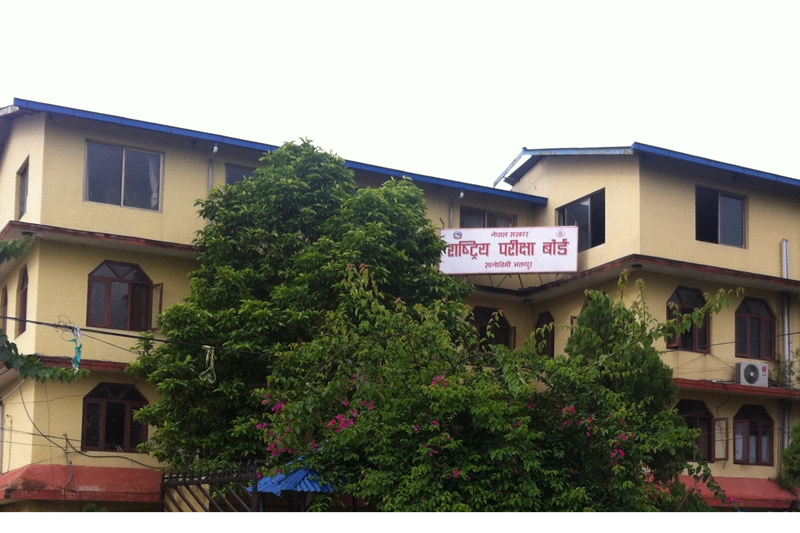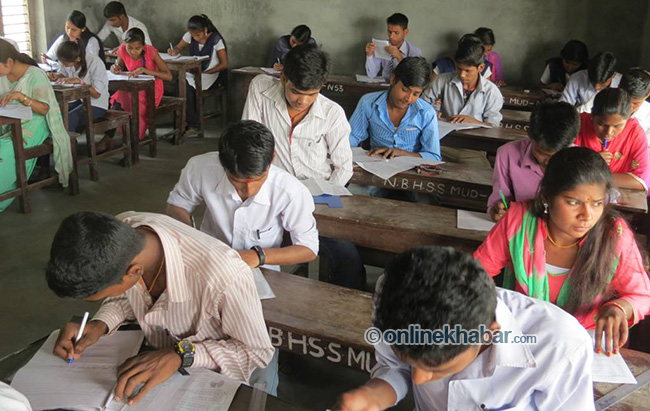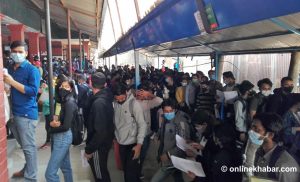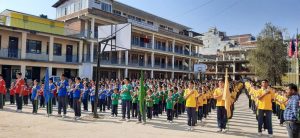A nexus of corrupt school administrators, government officials, parents, and teachers has turned higher secondary level exams into a sham.
Madhav Nepal has no doubt about what he saw over several mornings, in May 2018, on the playground of the Laxmi Secondary School in eastern Nepal’s Jhapa district.
Over 800 students from neighbouring schools were taking their grade 11 exams at the school that month. Nepal, a teacher at the school, was invigilating the exams in one of the classrooms. Between the long hours of invigilating, Nepal often stepped out of the classroom to stroll on the playground. On several occasions, he came across Ghanashyam Dangi, his colleague and assistant principal of the school, wandering about the ground donning his usual ‘French-cut’ beard and sunglasses.
When the results of those exams came out five months later, Nepal was taken by surprise. Dangi, who never took exams, had passed, with a GPA of 2.98, as a student of the Sanischare Secondary School. If passing was not enough, he had topped the exams among the students from that school.
“I didn’t see Dangi take any of the five exams,” Nepal says. “And yet he topped the exams. This is shocking and mysterious.”
Half dozen locals from Jhapa’s Arjundhara municipality spoke to Onlinekhabar and corroborated Madhav Nepal’s allegations: Dangi never appeared for an exam in May that year. They claim that Dangi had made his wife, Maya Gautam, also a teacher at the same school, take those exams.
The locals also claim Dangi sent Gautam to the exam hall in cahoots with Birendra Prasad Gupta, principal of the Laxmi Secondary School. To execute the fraud effectively, the locals say, Gupta appointed Dangi the assistant chief of the exam centre.
But things didn’t go as they planned. Dangi landed in the soup when Nepal and others spoke out. Locals formed a protest committee and asked Dangi and Gupta to resign, and the government formed a probe committee to look into the accusations.

When Onlinekhabar telephoned Dangi to seek his comments on the case, his wife answered the call. “The probe committee clearly says we are clean. The issue is over,” she said.
Dangi is neither the first nor the last person to manipulate Nepal’s school examination system. A two-month investigation by Onlinekhabar reveals that Government officials, school administrators, teachers, and guardians use their financial, political and administrative resources to manoeuver the system to work in their favour. And with legal loopholes and impunity that abound, the offenders perpetrate the offence, unchecked, for years.
Faulty mechanism
Multiple local sources Onlinekhabar spoke to–teachers, activists, and villagers–claim Dangi took admission at Sanischare School knowing his exam centre would be the Laxmi School, where he calls the shots. And his ploy paid off, albeit partially because the Board adopts a ‘faulty’ procedure to assign exam centres.
Established three years ago, the Board, which succeeds the Higher Secondary Education Board, is yet to frame rules for conducting examinations.
“We are still in the transitional phase,” says Krishna Prasad Sharma, acting controller of examinations.
Jayanti Satyal, former deputy controller and spokesperson for the then Higher Secondary Education Board, says a number of factors need to be taken into consideration while assigning exam centres. The factors she lists include the availability of classrooms and other basic amenities, the distance between the school of examinees and the host school, and the number of students enrolled. These are based on an HSEB regulation implemented in 1998. The regulation, however, does not define these factors in detail. This means that some schools can host the same school’s examinees for years.

Although the Board uses a two-decade-old regulation, the Ministry of Education, Science and Technology has issued several directives to amend its various provisions on an ad hoc basis. On April 6, 2011, the Ministry issued an order authorising a three-member district committee comprising the chief district officer, the district police chief and the district education officer to assign exam centres for grades 11 and 12.
Five years later, in 2016, the Ministry added the local development officer and the district chiefs of the Nepal Army, the Armed Police Force and the National Investigation Department to the committee.
But these changes, made at the district level, did not make any impact at the local level, where school principals and their confidants are in charge.
Moreover, even when they face allegations of misconduct, they get away with little or no punishment.
The Dangi case also exemplifies the lethargy that besets administrators responsible for taking actions against those sabotaging the exam system. After the protest committee led a sustained offensive against Dangi and Gupta, the then Chief District Officer Janak Raj Dahal assigned the District Education Officer Jaya Prasad Mahat, who was transferred to the district just a few days before the protest, to look into the case. Mahat now claims Gupta and Dangi are inculpable as per the documents he was provided with during his investigation.
However, BhishmaPaudel, who led the protest committee, claims Mahat and the other officers involved in the case were coerced into inaction by local politicians.
Mahat admits there were shortcomings in the process. “We are not an authority to investigate in-depth and take action.”
Institutional irregularities
A former teacher (who wishes to remain anonymous) at Brilliant Multiple Campus, a higher secondary school located at Chabahil in Kathmandu, recalls how invigilators including himself were instructed not to take action against students of Golden Gate International College sitting for grade 12 exams in April 2017. (Most private higher secondary schools in Kathmandu identify themselves as a ‘college’ rather than a ‘school’.)
“It was done in a subtle manner,” he says. “The instructions came from lower-level staff such as security guards. We were asked to allow Golden Gate students to do anything they wanted except make noise.”
Three Golden Gate students who took their grade 12 exams in April 2016 also say their schoolmates copied answers from one another even as invigilators at Brilliant looked the other way.

Housed in an eight-storey imposing building at Battisputali in central Kathmandu, Golden Gate is among the expensive schools in Kathmandu, with annual tuition fees going upwards of Rs 100,000 per student. It draws its authority from its association with its founder and CEO, Ramesh Silwal. Silwal is the chairman of the Higher Institutions and Secondary Schools’ Association Nepal, which holds sway in the formulation of the country’s education policy, and is also the member-secretary of the National Sports Council. He is also known to have close ties with Prime Minister KP Sharma Oli and the ruling Nepal Communist Party.
Unlike the Golden Gate, Brilliant mostly attracts students from lower-middle-class backgrounds. It charges around 30,000 rupees per student annually. Its principal, Durga Prasad Nepal, did not respond to Onlinekhabar’s request for comment.
Silwal claims to be committed to fair and transparent exams and says he has never lobbied to ensure flexible exam norms for his students. “If this had been the case, I’d have ensured 100 percent pass results,” he says.
However, Board officials acknowledge that high schools in Kathmandu use their clout to manipulate exam results, which are vital for publicity of the schools: the higher the pass percentage, the more the students getting enrolled the following year.

A former examination controller, who is now associated with a different department of the Board and wishes to remain anonymous, says the Board leadership is unwilling to take action against the irregularities in the exam system. He claims the schools located in the Kathmandu Valley are ahead of other institutions in terms of using political and financial clout to rig the system. He himself was allegedly relieved from his position in 2018 after a ‘powerful’ school’s founder was barred from sitting in the subject evaluation committee due to a conflict of interest.
Former HSEB spokesperson Satyal corroborates the former controller’s claims. She says investors are often affiliated with more than one school without the knowledge of the Board. The same investor might be affiliated with the host school and the school of the examinees, in which case exam ethics are most likely to be compromised.
Another Board official who wishes to remain anonymous says whereas the Board notifies exam centres outside the valley a month before the exams begin, there is just a two-day window for the purpose when it concerns the Valley. “This is because power brokers take time to choose exam centres of their liking,” he says, adding that at least 20 percent exam centres in the valley are rigged.
Greedy officials
Onlinekhabar’s investigation reveals that power brokers do not need any political connection to access the Board officials and tamper with the system. Bribery, the former examination controller says, is a common practice at the Board.
Educationist Mana Prasad Wagley says Board officials’ financial greed is what keeps the fraud going. “This is a form of corruption that originates due to the lack of accountability among officials,” he adds.
More than a dozen teachers from schools across Nepal Onlinekhabar spoke to concur that wealthy schools also bribe officials of their exam centres directly to ensure that the invigilators ‘support’ their students.
Principals of two Kathmandu-based secondary schools who wish to remain anonymous agree that almost every private school in the capital city buys the support of invigilators. A school earns thousands of rupees from a student every year, and if it spends Rs 25,000 to Rs 30,000, it can improve the results of all students for that year.
“It’s not only possible but is practical as well,” says one of the principals.
The exam centres also expect kickbacks. If they fail to receive it, they direct their anger at the students of those schools. “I know that an exam centre in my neighbourhood gave unnecessary trouble to the students of two schools that failed to bribe,” says the principal.
‘Supportive’ guardians
While students, officials, and school administrators try to rig the exams to suit their interests, guardians also use their influence to help their children cheat.
On April 27, 2019, a group of guardians of students studying at the Srijana Secondary School in Pokhara organised a party for the invigilators of the government-run Barahi School. A source familiar with the school says the invigilators, who were assigned to oversee grade 12 exams scheduled to begin the next day, were taken to a restaurant in Pame, a small, touristy area near the Lakeside in Pokhara.
“They were offered the restaurant’s signature fish dishes and drinks,” says the source. “After the party was over, the invigilators agreed to help the students pass the exams.”
However, the Barahi School administration learned of the party the next day and relieved the invigilators of their duties. Though both the schools refuse to acknowledge the incident officially, a source close to the Barahi School principal confirms the incident.
These are only the symptoms of a larger problem plaguing the country’s examination system, say experts. The problem may seem confined toJhapa, Kathmandu, and Pokhara, but is likely to have spread across the country.
Suprabhat Bhandari, president of the Nepal Guardians Federation, a coordinating body of 10 guardians’ organisations, says he has heard of many such cases in the remote Karnali region over the past few years.
Santosh Aryal, a former examination controller, says schools in many parts of the country bargain with the Board to find their favourable exam centres every year. He, however, claims exam centre-fixing has ended in the Kathmandu valley.
Root causes

Educationists and administrators alike say systemic failures have led to the perpetuation of exam rigging in Nepal. For Bhandari of the Nepal Guardians Federation, authorising the ‘non-educational’ body to fix exam centres is in itself faulty. He claims ‘powerful’ institutions, local politicians and bureaucrats can easily influence district-level government officials as was evident in the probe into the Dangicase.
Bhandari adds that the Nepali practice of assigning security officials to conduct exams is against the globally accepted principles of education administration. When exam centres are guarded by army and police personnel instead of teachers, students and guardians perceive exams as being ‘tough’. So, they seek to ‘make them easy’, which means they get involved in rigging. When an exam is considered a security issue, it paradoxically promotes rigging.
Bhandari adds that most Nepali guardians believe certificates are more important than practical skills learned by a student. He, however, blames various government policies for imparting this fallacy on innocent’ guardians. He describes the three-hour examination system practiced at the school-level in Nepal since the beginning of the School Leaving Certificate (Grade 10) exam, now renamed as Secondary Education Examination, in 1934 AD as ‘unscientific’. In this system, any student who studies hard throughout the year might fail, if he or she falls sick on the exam day. With little means to evaluate their performance around the year, the students internalise that what matters most is the score.
For Bhandari, this false notion motivates both students and guardians to get involved in the activities that amount to rigging. But he maintains that most of the present irregularities happen due to mala fide intentions of the students, parents, and officials, and not faulty policies.
Mahashram Sharma, a former secretary at the Ministry of Education, agrees with Bhandari. He says the education system in Nepal has failed to perceive examination as an ‘educational’ event. “We should have considered exams an affair between teachers and students, and teachers should have been given the authority to evaluate,” he says.
“Examinations are fair at some places whereas there are irregularities at other places,” Sharma says. “Had it been a policy issue, the irregularities should have existed everywhere.”
Sharma gives a historical example to substantiate his argument that, in this case, the intention is a more crucial factor than policy. Since the beginning, the government announced the names of ‘board first’ students (among boys and girls) while publishing SLC exam results. However, it abolished the tradition around a decade ago when it realised that tradition promoted unhealthy competition among wealthy schools. The tradition had a genuine objective of motivating studious students, but people with mala fide intentions found a loophole in the process and played foul.
Reforming the system
Educationist Wagley says an entirely new procedure should be adopted to eliminate the possibilities of creating loopholes in the system and affecting the results. He says the authorities can, for instance, divide schools into clusters based on their geographic proximity and draw lots to decide which school is allotted to a particular exam centre. Also, they can send students of one school to multiple exam centres so that the school finds it difficult to influence the performance of each student differently, Wagley adds.

But Sharma and Bhandari say the problem has spread across the collective unconscious of the society, and that policy or procedural reforms might not work unless there is a change in the mindset of the people.
According to Sharma, local governments, which are constitutionally mandated to manage the secondary education system, should take initiatives to address the problem. Likewise, schools should stop promoting their pass percentage and individual students’ scores to attract more students and instead make teachers responsible for the qualitative and holistic growth of the students, he adds.
“So far, we’ve failed to learn what education is and how one should prepare for an exam,” Sharma says. “We need to change the entire modality. This is a big transformation, and it takes time.”
This story was reported under the investigative reporting fellowship offered by the Media Foundation.























